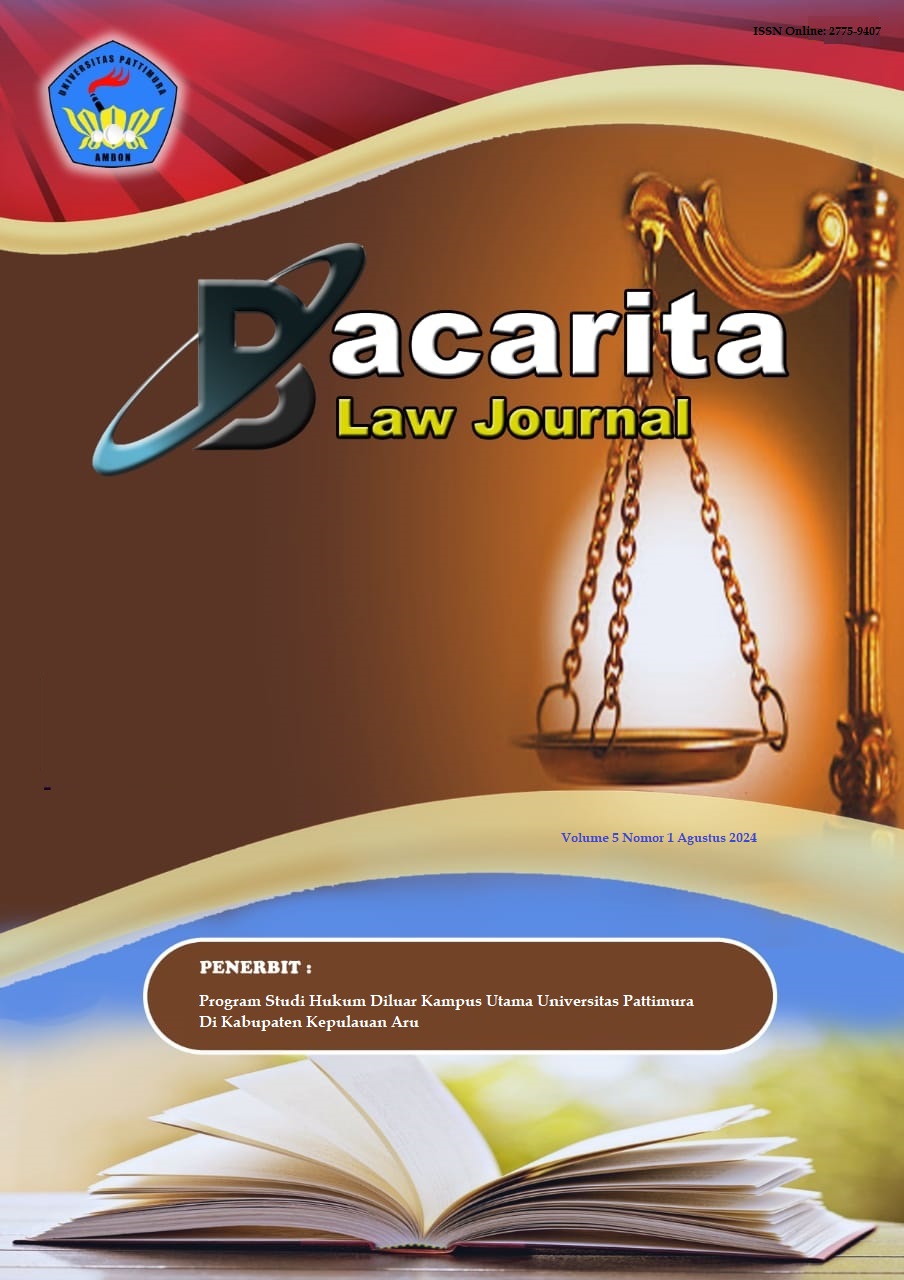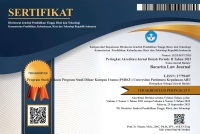Legal Protection of Trade Secrets, Industrial Design And Integrated Circuit Layout Design In Indonesia
Abstract
The government of Indonesia is compelled to bring national rules for the protection of intellectual property rights into line with international norms as a result of the ratification of TRIPs. This study employs a qualitative descriptive research strategy rooted on normative legal theory. In order to assess how well national laws have met the international requirements set forth by TRIPs, data was gathered via literature reviews of primary, secondary, and tertiary legal sources. This study's overarching goal is to determine how well Indonesia's various laws pertaining to IPR—such as those pertaining to trade secrets, industrial design, and integrated circuit layout design—are in sync with the provisions of the TRIPS Agreement. The findings demonstrate that these three statutes have significantly incorporated the fundamental elements governed by TRIPs. Trade secret and integrated circuit layout design protection periods, for instance, have been tweaked to meet the bare minimum requirements imposed by TRIPs. Furthermore, national legislation have also strictly governed the exclusive rights that intellectual property holders have, such as the ability to sue for damages in a civil court and get compensation, and the criminal penalties that those who violate these rights face. Nevertheless, there were obstacles to proper legal enforcement and execution in the field, particularly with regard to the level of legal knowledge among corporate players and the general public, as this study also revealed. As a result, this study significantly advances the cause of bringing Indonesian intellectual property legislation up to par with global norms. To maximize the advantages for innovation and economic development that current legislation may provide, Indonesia has to adopt strategic initiatives including bolstering law enforcement and raising public understanding about the significance of preserving intellectual property rights.
Downloads
References
Journal Article
Aliim, Muhammad Syaiful, Hari Siswantoro, dan Retno Supriyanti. “Desain Ulang Modul Paten Dan Cipta Dari Sistem Informasi Hak Kekayaan Intelektual Universitas Jenderal Soedirman.” Dinamika Rekayasa 16, no. 2 (24 Agustus 2020): 91–96. https://doi.org/10.20884/1.dr.2020.16.2.348.
Arika, Defi, Elza Syarief, dan Yudhi Priyo Amboro. “Perlindungan Hukum Atas Mode Pakaian Sebagai Desain Industri Di Indonesia.” Jurnal Yustisiabel 7, no. 2 (12 Oktober 2023): 264–83. https://doi.org/10.32529/yustisiabel.v7i2.2429.
Bakung, Dolot Alhasni, Sri Nanang Meiske Kamba, Mohamad Hidayat Muhtar, Zamroni Abdussamad, dan Julius T. Mandjo. “Kontra Persepsi Asas Kebebasan Berkontrak Dalam Uu No 2 Tahun 1960 Tentang Bagi Hasil Pertanian Dengan Sistem Ijon (Penyuluhan Hukum Pada Masyarakat Di Desa Kaidundu Kecamatan Bulawa Kabupaten Boen Bolango Provinsi Gorontalo).” Jurnal Nusantara Berbakti 1, no. 3 (23 Juni 2023): 81–95. https://doi.org/10.59024/jnb.v1i3.164.
Bakung, Dolot Alhasni, dan Mohamad Hidayat Muhtar. “Determinasi Perlindungan Hukum Pemegang Hak Atas Neighbouring Right.” Jambura Law Review 2, no. 1 (28 Januari 2020): 65–82. https://doi.org/10.33756/jalrev.v2i1.2400.
Bakung, Dolot Alhasni, Viorizza Suciani Putri, Mohamad Hidayat Muhtar, Weny Almoravid Dungga, dan Nirwan Junus. “Criticizing Potential Deviations in the Role of Environmental Impact Analysis after the Enactment of the Job Creation Law.” E3S Web of Conferences 506 (2024): 06005. https://doi.org/10.1051/e3sconf/202450606005.
Gobel, Rahmat Teguh Santoso, Mohamad Hidayat Muhtar, dan Viorizza Suciani Putri. “Regulation And Institutional Arrangement of Village-Owned Enterprises After The Work Creation Era Applied.” Jurnal Pamator: Jurnal Ilmiah Universitas Trunojoyo 16, no. 1 (30 Maret 2023): 15–33. https://doi.org/10.21107/pamator.v16i1.19135.
Harahap, Tuti Khairani, Yuyut Prayuti, Nining Latianingsih, Amsari Damanik, Tiyas Maheni, Ida Farida, Mohamad Hidayat Muhtar, dan Mustaqim. “Pengantar Ilmu Hukum.” Penerbit Tahta Media, 30 Mei 2023. https://tahtamedia.co.id/index.php/issj/article/view/255.
Irawan, Muhammad Z., Monika K. Putri, Prawira F. Belgiawan, dan Reslyana Dwitasari. “Analyzing Commuters’ Behavior on Egress Trip from Railway Stations in Yogyakarta, Indonesia.” Open Transportation Journal 11 (2017): 53–66. https://doi.org/10.2174/1874447801711010053.
Nordin, Rohaida, dan Siti Safina Abu Bakar. “Malaysian batik industry: Protecting local batik design by copyright and industrial design laws.” International Journal of Business & Society 13, no. 2 (2012). http://www.ijbs.unimas.my/repository/pdf/Vol13No2-paper3.pdf.
Qamar, Nurul, Muhammad Syarif, Dachran S. Busthami, M. Kamal Hidjaz, Aan Aswari, Hardianto Djanggih, dan Farah Syah Rezah. Metode Penelitian Hukum (Legal Research Methods). CV. Social Politic Genius (SIGn), 2017.
Rahman, Irsan, Mohamad Hidayat Muhtar, Novita M. Mongdong, Rahmat Setiawan, Beni Setiawan, dan Henry Kristian Siburian. “Harmonization of Digital Laws and Adaptation Strategies in Indonesia Focusing on E-Commerce and Digital Transactions.” Innovative: Journal Of Social Science Research 4, no. 1 (18 Januari 2024): 4314–27. https://doi.org/10.31004/innovative.v4i1.8240.
Sudjana. “Penerapan Sistem Hukum Menurut Lawrence W Friedman Terhadap Efektivitas Perlindungan Desain Tata Letak Sirkuit Terpadu Berdasarkan Undang-Undang Nomor 32 Tahun 2000.” Jurnal Al-Amwal 2, no. 2 (2019). http://ojs.staibhaktipersada-bandung.ac.id/index.php/Alamwal/article/view/48.
Sulasno, Sulasno. “Lisensi Hak Kekayaan Intelektual (HKI) Dalam Perspektif Hukum Perjanjian Di Indonesia.” Adil: Jurnal Hukum 3, no. 2 (2012): 352–352. https://doi.org/10.33476/ajl.v3i2.61.
Yuliasih, Yuliasih. “Perlindungan Hukum Desain Industri Dalam Pelaksanaan Prinsip Keadilan Menurut Teori Keadilan John Rawls (Studi Kasus Putusan Nomor 35 PK/PDT.SUS-HKI/2014).” Notarius 8, no. 2 (2015): 152–279. https://doi.org/10.14710/nts.v8i2.10263.
Book
Correa, Carlos. Trade Related Aspects of Intellectual Property Rights: A Commentary on the TRIPS Agreement. Oxford University Press, 2020.
Djubaedillah, R., dan Muhamad Drs Djumhana. Hak Milik Intelektual (sejarah, teori dan prakteknya di Indonesia. Bandung: Citra Aditya Bakti, 2003.
Hariyani, Iswi. Prosedur Mengurus HAKI Yang Benar. Yogyakarta: Pustaka Yustisia, 2010.
Riswandi, Budi Agus. Masalah-masalah HaKI kontemporer. Bandung: GitaNagari, 2006.
Saidin, O. K. Aspek hukum hak kekayaan intelektual (Intellectual property rights). Jakarta: Raja Grafindo Persada, 2015.
Thesis, Online/World Wide Web and Others
Amir, Sulfikar. “The development of industrial design in Indonesia: a case study in the electronic industry.” PhD Thesis, Arizona State University, 2000.
Hartono, Sri Rejeki. “Rahasia Dagang Suatu Pengantar.” Makalah disampaikan pada Lokakarya dan Pengelolaan HAKI, Semarang, 2006.
Copyright (c) 2024 Bujang Ali, Dipo Setia Hady Akbar Jaya, RS Mohammad Al Amin BA, Muhammad Reza Fahlevi, Acong Acong, Sutrisno Sutrisno

This work is licensed under a Creative Commons Attribution-NonCommercial 4.0 International License.
Authors who publish their manuscripts in this Journal agree to the following conditions:
- The copyright in each article belongs to the author, as well as the right to patent.
- Authors are able to enter into separate, additional contractual arrangements for the non-exclusive distribution of the journal's published version of the work (e.g., post it to an institutional repository or publish it in a book), with an acknowledgment of its initial publication in this journal.
- Authors are permitted and encouraged to post their work online (e.g., in institutional repositories or on their website) prior to and during the submission process, as it can lead to productive exchanges, as well as earlier and greater citation of published work.
- Authors have the right to self-archiving of the article (Author Self-Archiving Policy)















